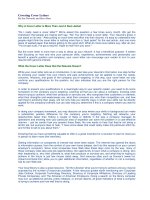Cover Letters
Bạn đang xem bản rút gọn của tài liệu. Xem và tải ngay bản đầy đủ của tài liệu tại đây (40.08 KB, 2 trang )
Cover Letters
If the resume is the piece of paper that gets you to the interview then the cover
letter is the one that will get the employer to read the resume. So the resume and
cover letter share the same goal- to get your employer to pick you! The best
cover letters spark the employer’s interest and create an impression of
competence.
Just like what you did with your resume, you should study the employer's
requirements and needs first before you start writing. Once you have those
points, put the most important items first and support this with facts and
examples. The key is to demonstrate to the employer how your background,
education, work experiences and abilities can meet the needs of the employer.
You should never send a resume without a cover letter unless specifically
instructed to do so by the employer. Sending a resume without a covering letter
is like starting an interview without shaking hands. The main purpose of the cover
letter is to introduce your resume and highlight the main points that are most
relevant to the job being advertised.
The key to a good cover letter is to personalise the letter. It is more effective if
you do some research on the company before hand and write a cover letter that
is tailored to the company and the job position.
Your cover letter should provide the following details.
• Why are you writing?
• Why are you interested in the job?
• Why would the company be interested in you?
• What is your next step?
These questions should be answered in 3 main sections of your cover letter.
1) Introduction
Introduce yourself and explain why you are writing to the employer. In the
introduction you should name the position or field of the job being listed. If
someone has suggested you get in touch with the employer then do mention the
recommendation. If you are responding to an advertisement, refer to it and the
source that published it. In a sentence or two explain why you are the best
candidate for the job (talk about your skills).
2) Body
In the body section, match your background to the experience and skill
requirements of the job position. It's is good if you can talk about your
experiences that relate to the job at hand. You should identify your strengths,
accomplishments and results. Do not repeat what is stated in your resume.
Instead, summarise your most relevant qualifications or provide additional details
about a noteworthy accomplishment.
3) Closing
Your closing should be brief. You can end the letter with an active statement,
such as an offer to contact the employer within a specific period of time, usually
one or two weeks. You have to be proactive and continue to keep your name in
the interviewer’s mind.” It is crucial that you provide details for them to reach you;
this is usually by phone and/or email. Close the letter by thanking the reader for
their time and consideration.
Cover letter tips
• Like the resume, the cover letter should be written specifically targeted
towards the job at hand. Do not write one cover letter and send it to
everyone.
• Cover letters are suppose to highlight your talents and experience.
• This can’t be stressed enough - your cover letter, like your resume, should
be perfect! Make sure there are no grammatical or spelling errors. Don’t
rely on your computer’s spell check. Get a friend or teacher to read it over
for you.
• Every cover letter should fit on one page.









